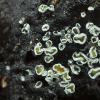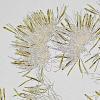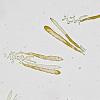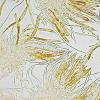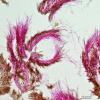
01-01-2026 18:35
Original loamy soil aside a artificial lake.The co

31-12-2025 19:27
Collected from loamy soil, at waterside (completel

30-12-2025 16:44
Pascal DucosBonjour,Une anamorphe rose stipitûˋe, trû´s nombre

30-12-2025 17:14
 Bernard CLESSE
Bernard CLESSE
Bonjour û toutes et tous,Pourriez-vous aider Albe

29-12-2025 10:15
Hulda Caroline HolteHello, I found and collected this propoloid ascom

30-12-2025 09:04
Hello.A Pyrenomycete sprouting sparsely but very d

29-12-2025 17:44
Isabelle CharissouBonjour,J'aimerais savoir si d'autres personnes au
Lachnum aff patulum ?
Miguel ûngel Ribes,
15-08-2008 01:46
 The last one today
The last one todayOn the bark of a live "ViûÝatigo" (Persea indica), in a laurisilva forest. No more than 2 mm diameter, inside yellow-grenish and white hairs. Asci 8 spores, biseriated, amiloid, with croziers. Paraphysis filiform, not enlarged at the apex and longer than asci. Cilindrical and not septated spores. Hairs filiform, not enlarged at the apex, septated and with granular surface.
Sporal measure (1000x, in water, fresh material)
5.6 [7.6 ; 8.9] 11 x 1.8 [2.1 ; 2.3] 2.7
Q = 2.4 [3.4 ; 4.1] 5.2 ; N = 17 ; C = 95%
Me = 8.28 x 2.22 ; Qe = 3.77
Thank you
Miguel ûngel Ribes,
15-08-2008 01:48
Miguel ûngel Ribes,
15-08-2008 01:50
Hans-Otto Baral,
15-08-2008 15:35

Re:Lachnum aff patulum ?
Its Proliferodiscus pulveraceus. Wonderful how you photographed the croziers! This species may sometimes also be without croziers. A good character is the reaction in KOH of the ectal excipulum (also base of hairs): turning violet!
The variable arrangement of the spores inside the asci is only seen in dead asci. In living asci they are always biseriate.
Are your finds all from Macaronesia? Which island?
Zotto
The variable arrangement of the spores inside the asci is only seen in dead asci. In living asci they are always biseriate.
Are your finds all from Macaronesia? Which island?
Zotto
Miguel ûngel Ribes,
16-08-2008 12:54

Re:Lachnum aff patulum ?
Yes, all of them are from Macaronesia, from Tenerife: Stictis and Proliferodiscus pulveraceus from "laurisilva" forest, and Propolis aff viridis from eucaliptus forest.
Thank you for "Proliferodiscus pulveraceus", I had never thought in this species.
Thank you for "Proliferodiscus pulveraceus", I had never thought in this species.



